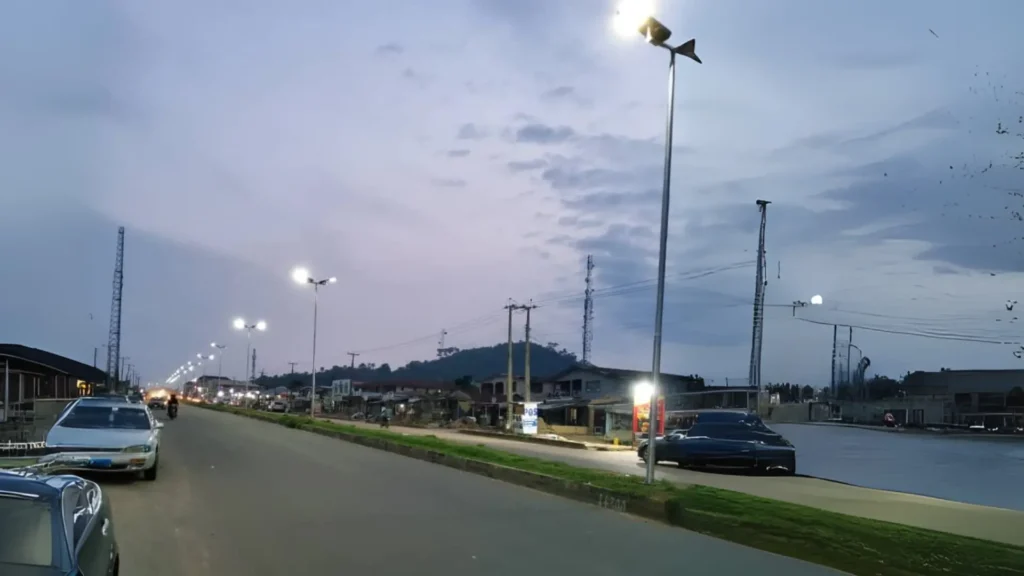As Nigeria’s urbanization accelerates and power shortages continue to worsen, solar lighting has emerged as an ideal solution for many communities facing infrastructure challenges. Recently, a newly developed residential community in Nigeria deployed Sresky SSL-910 integrated solar streetlights, effectively addressing issues of inadequate nighttime lighting and public safety concerns, thereby bringing tangible improvements to residents’ quality of life and promoting sustainable development benefits.This project not only significantly enhanced the community’s nighttime safety and quality of life but also demonstrated the replicability and long-term value of off-grid solar lighting systems in developing countries.
1. Project Background: Nigeria’s Nighttime Lighting Challenges
1.1 Key Challenges Faced Locally
As Africa’s most populous nation, Nigeria has long faced challenges such as insufficient power supply and underdeveloped infrastructure. According to World Bank data, approximately 40% of the country lacks reliable electricity, especially in suburban areas and newly developed residential zones where frequent power outages leave lighting systems inoperable.
The community encountered the following primary issues:
-
Unstable power supply: Frequent blackouts prevent traditional grid-connected streetlights from maintaining illumination, leaving roads dark and unsafe.
-
Nighttime safety risks: Poor lighting increases the risk of theft, assault, and other crimes.
-
High energy costs: Grid-powered lighting incurs high and fluctuating electricity bills.
-
Strong residential demand: Residents urgently seek reliable, energy-efficient solutions to improve nighttime mobility and quality of life.
To address these challenges, the residential community opted for a clean energy solution by deploying a high-performance solar street lighting system.
2. Needs Analysis and Product Selection
2.1 Core Lighting Requirements
Through on-site inspections and environmental assessments, the project team identified the following needs:
-
High brightness with wide lighting coverage
-
Off-grid, energy-efficient, and environmentally friendly operation
-
Durable performance in Nigeria’s hot, rainy, and dusty climate
-
Simple installation and maintenance to reduce labor costs
-
Smart control features for sensing and energy-saving functionality
Based on these requirements, Sresky recommended its flagship product—the basalt integrated solar street light.
3. Sresky basalt: Why It Was the Best Choice
The Sresky basalt streetlight is engineered for high-demand environments, combining powerful lighting, intelligent control, and durable structure to fully meet the needs of this Nigerian project.
3.1 Exceptional Lighting Performance
-
Brightness up to 10,000 lumens
-
Type 4S light distribution, suitable for roads, intersections, and public areas
-
120° wide-angle motion sensing and 8-meter detection range
3.2 High-Efficiency Solar System
-
High-conversion monocrystalline silicon solar panels ensure consistent year-round power generation
-
Built-in lithium batteries with TCS temperature control system allow stable operation in temperatures up to 60°C
-
Battery lifespan exceeds 2,000 charge cycles, providing up to 5 days of lighting during consecutive rainy weather
3.3 Multi-Mode Intelligent Lighting System
Equipped with Sresky’s proprietary ALS2.4 adaptive energy-saving technology, which automatically adjusts brightness according to environmental conditions. Supports three lighting modes:
-
M1: 30% constant brightness + PIR sensing until dawn — energy-saving default
-
M2: 100% brightness for 5 hours + 25% (PIR) + 70% until dawn — ideal for high-traffic areas
-
M3: 70% constant brightness — suitable for main roads and commercial zones
3.4 Robust Integrated Structure
-
IP65 waterproof and IK08 impact-resistant
-
One-piece aluminum alloy housing, designed to resist corrosion and withstand strong winds
-
Modular design allows for quick installation and simplified maintenance without complex wiring
4. Installation Design and Implementation
The installation plan was tailored to the basalt streetlight’s optical properties and the area’s terrain:
-
Installation height: 8 meters for optimal light coverage
-
Spacing: 25 meters between lights to avoid dark zones
-
Foundation: C20 concrete bases ensure pole stability
-
Commissioning: Plug-and-play setup enables quick deployment and immediate operation
5. Project Outcomes and Long-Term Impact
5.1 Safer Communities After Dark
The high-brightness basalt lights now illuminate community roads, parks, and pathways. On-site feedback confirms reduced crime rates, improved traffic safety, and enhanced nighttime peace of mind.
One resident shared: “Now I no longer worry about going out at night; the entire community is well-lit.”
5.2 Enhanced Resident Quality of Life
-
Extended activity hours: Families enjoy nighttime walks, social interactions, and outdoor play
-
Growth of the night economy: Improved lighting encourages local vendors and small businesses
-
Stronger community identity: Consistent and modern solar lights beautify the neighborhood and foster pride
5.3 Economic and Environmental Benefits
-
Zero electricity bills: 100% solar-powered, eliminating long-term energy costs
-
Low maintenance expenses: Modular design and smart diagnostics reduce malfunctions and repair needs
-
Lower carbon emissions: Each basalt unit reduces CO₂ emissions by approximately 0.3 tons annually
5.4 Social Demonstration Value
The project’s success has attracted attention from neighboring communities and government agencies. As a scalable and cost-effective solution, the Sresky basalt light is gaining traction as a model for street lighting upgrades across Nigeria.
6. Summary: Smart Solar Lighting Supports Sustainable Communities
The Sresky basalt solar streetlight project clearly demonstrates how intelligent, modular, and high-performance solar lighting can resolve energy and lighting challenges in developing nations. Beyond improving nighttime conditions, it fosters safer, more vibrant, and eco-friendly communities.
Looking forward, Sresky will continue to deliver dependable smart solar lighting systems to more global regions, supporting the transition to zero grid dependency and low-carbon living.

